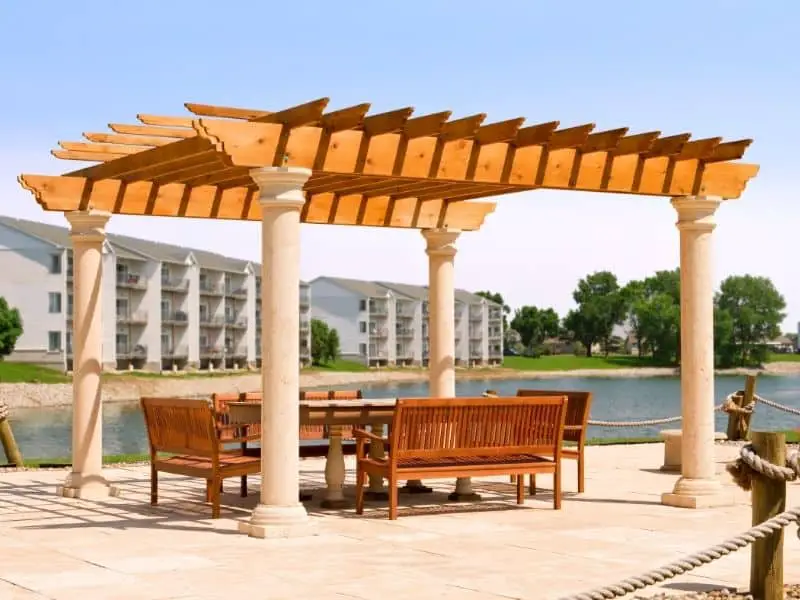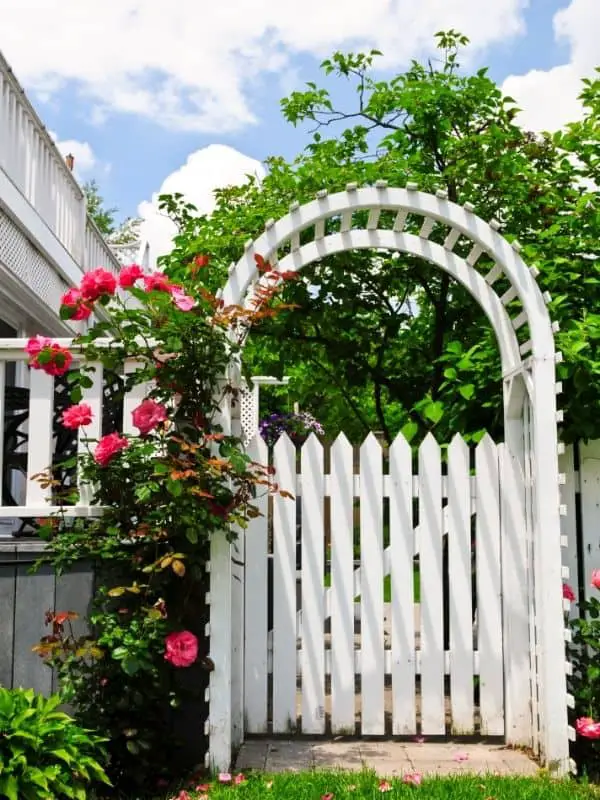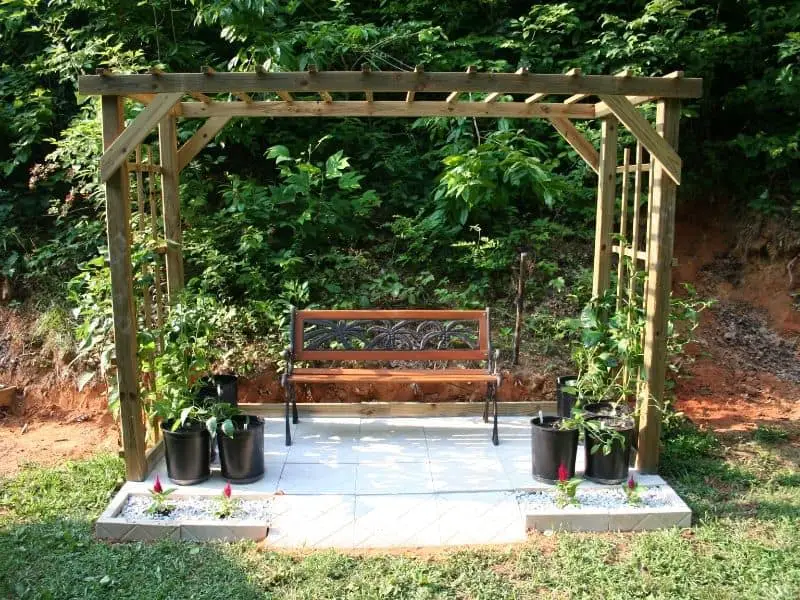Pergolas and arbors (arbours if you’re across the pond or in the Great White North) are often mixed-up and misunderstood. Pergolas are often mistaken for unfinished structures, and arbors are often mistaken for pergolas. A casual glance can yield no great discernable differences in many cases.
The fact is that they are very similar in many ways, but they have some key differences that can help you determine which is which. So, join me as I delve into one of the greatest backyard mysteries of all time by attempting to answer: What’s the difference between a pergola and an arbor?
There are three major differences between pergolas and arbors: size, intended use, and typical locations. Pergolas are usually larger than arbors. Pergolas are also intended for small or large gatherings underneath, while arbors are usually too small for such endeavors. Finally, since they differ in size and function, you can generally tell which is which by where they are located and what’s underneath each.
What is a Pergola?

A pergola is a combination of decoration and utility. Since there are many different styles of pergolas, they can be designed to fit nearly any aesthetic, complementing nearby structures and adding a little something extra to a dull space.
They are typically built with at least four posts fastened securely to the ground. These posts serve to hold up the crossbeam structure above. Some pergolas have widely-spaced beams while others have a closely-spaced latticework structure on top.
Pergolas are often much larger than arbors and are of square or rectangular construction. There are pergolas available at 6.5’ x 6.5’. Common medium-sized pergolas measure 12’ x 12’, while large-pergolas can be 20’ x 20’ or larger.
What Are Pergolas Used For?
Aside from size, the other major difference between pergolas and arbors is their intended uses. Since pergolas are large enough to sit under, they are often used to provide a kind of outdoor room for lounging or entertaining. They can provide shade, which makes them a nice place to enjoy the outdoors without getting too hot or suffering from a sunburn.
Large pergolas may be used over a dining table for outdoor dinners, or over a collection of outdoor furniture that can accommodate many people at once. Some people also like to use pergolas as structures for climbing plants, like grapevines, honeysuckle, or ivy.
Common Pergola Features
A pergola’s use can be changed with a few simple additions or subtractions. You can put a weather-resistant cloth barrier over the top to create more shade and some protection from the elements. You can also use curtains or screens around the sides to provide privacy. Some pergolas are even made with roofs that can open or close with the push of a button.
Common Pergola Materials
There are many different options available when it comes to pergola materials. Here are a few:
- Wood – The most common and cost-effective option.
- Aluminum – Nearly as cheap as wood, but less common.
- Fiberglass – One of the more expensive options, but long-lasting.
- Vinyl – Vinyl pergolas are resilient and affordable.
- Steel – Steel is usually used for large pergolas in public spaces.
Where Are Pergolas Usually Located?
By now you can probably guess where pergolas are usually located. Most often they are found in backyards, next to pools, in gardens, or attached to the house. It’s common to find a pergola over a patio or a deck. They can also be found in parks and public gardens around the world. Sometimes they’re easily identifiable, other times they look more like a work of art than anything else.
What is an Arbor?

Arbors often look like miniature pergolas, which is why it’s common for people to confuse the two. As you can probably guess, arbors often have four posts secured in the ground. However, those posts are usually much smaller than those of a pergola, because they don’t have to support as much weight. Also, arbors don’t usually have any more than four support posts, unlike pergolas.
Some arbors are of an arched construction, rounding at the top instead of meeting the top at right angles like pergolas. These are generally considered “classic” arbors.
Sizes range for arbors, but not at much as pergolas. A small arbor can have a width of as little as 3-feet, a height of as little as 5-feet, and a depth of around 1.5-feet. Large arbors are generally around 10-feet wide, a height 12-feet or more, and a depth of 6-feet. Most commonly, arbors are around 4.5-feet wide, 6-feet tall, and 2.5-feet deep.
What Are Arbors Used For?
Arbors are used more as an entrance archway. They are also a combination of aesthetics and function, but their use is limited due to their size. In this way they are less versatile than pergolas, but they can be a very nice addition to a yard or garden that seems to be a little dull or lacking.
Arbors aren’t designed to provide shade or a place to lounge, but they are useful for growing climbing plants. Their latticework and somewhat open structures make them ideal for vines and other climbers.
Common Arbor Features
Arbors don’t have many feature options like pergolas do. Most often you’ll see them with vines growing on them, or attached to a fence with a gate underneath. However, sometimes you’ll see specialty arbors, like those with a small, built-in bench underneath. These types of arbors aren’t common, but they are available. There are different styles of arbors, a few of which we’ve listed below.
- Moon-Gate Arbors – These arbors are wide and designed to resemble a three-quarter moon. They’re typically made of metal and are ideal for climbing plants.
- Grape Arbors – These are flat-topped arbors designed to hold heavy grapevines. Although usually smaller than pergolas, they look identical.
- Gabled Arbors – The triangular, gabled roof of these arbors gives them a unique style that contrasts with the typical arched gable. They are typically made of wood and are common in English gardens.
Common Arbor Materials
There are several different choices available for arbor materials. The most common are wood and metal, but you can also find them available in vinyl.
Where Are Arbors Usually Located?
Arbors can be found in many of the same areas as pergolas, like backyards, parks, and gardens. However, they’re usually above a walkway or denote an entrance of some kind. Unlike pergolas, you often see small arbors in people’s front yards. Many times these arbors are built right into the fence and have a gate underneath.
In Conclusion
Now that you’re an expert on the differences between pergolas and arbors, you’ll be able to decide which one is best for your yard. Even better, you’ll be able to correct someone if they get the two mixed up! Okay, maybe I’m the only one who takes pleasure in that.
Anyway, to recap, the differences are generally apparent in size, location, and intended use. You can’t usually sit comfortably under an arbor because there’s not much room. Even if you did, it probably wouldn’t provide much shade or protection. Likewise, putting a pergola over a walkway may be overkill (unless your walkway is very large). The two share many of the same characteristics, but they are very different structures

